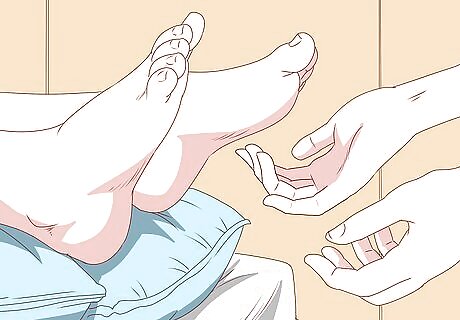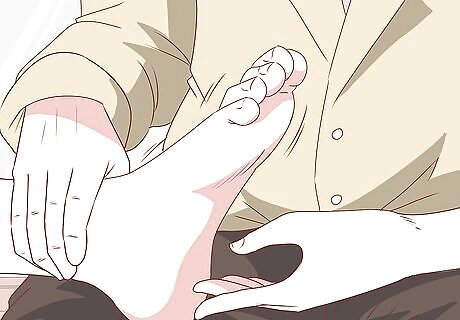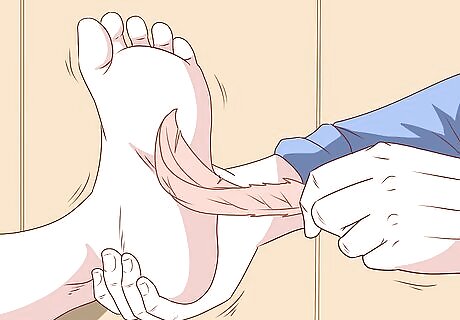
views
Targeting Your Victim

Set your sights on a target. Tickling sets off involuntary muscle responses in our bodies, meaning that we cannot control our reaction in laughing, smiling, or shrieking. Most people are ticklish in some way, then, whether all over or just in a small “tickle spot.” You won’t have to look far to find a target. Choose someone you know, as most strangers will not take kindly to a random tickle. Even if you know the target, be sure that they're comfortable with being touched. Target someone like a close friend, sibling, or cousin.

Read your victim’s cues. Some people love to be tickled, while for others the experience is very unpleasant. We laugh during tickling because it is an automatic reaction, not because we necessarily like it or because it is enjoyable. Non-consensual tickling has even been used as a form of torture in the past. Be sure that the target will have fun with your surprise attack, or else you may cause them physical or emotional distress. Some people have a deep dislike for tickling. Have you tickled your target before? Did they just laugh, for example? Or did they fight back, ask you to stop, or try to run? You may want to hold back in the latter case.
Focus on tickle spots. Some places on the human body are more prone to ticklishness than others, like the soles of the feet, the toes, and the armpits. For your tickling reference, know these spots and target them. Other high-priority tickle areas include the belly, the sides (around the ribcage), the backs of the knees, the back of the neck, and the ears. Your victim may be more susceptible to tickling in one or more of these areas than in others. Experiment. Find out where they are most vulnerable.

Use different forms of touch. Another way to heighten the experience is to vary the kind of touch you use when tickling. Mix it up. Sometimes a light stroke is best, while at others you should really aim for a full on hard tickle. For example, try sneaking up on your target and lightly touching the back of their neck with the tips of your fingernails. This sort of touch is the kind that sends shivers up the spine. A lot of people have long nails. This can be a big advantage for you when tickling someone by spider tickling (lightly running all your fingers) or stroking. To get a bigger response and more laughter, take both hands and really go for the person's vulnerable spot. Mix up speed as well. At times, tickle fast and slow.
Tickling Friends for Fun

Use the art of surprise. Scientists think that the way we respond to tickling has something to do with surprise and that we can control our response if we expect it. Think about it. Can you tickle yourself? Not very well because your body knows what is coming. The key to getting a good response may be surprise. One good idea is to very lightly walk your fingers up and down your victim's sides. Or, you might try casually approaching the target. Put your arm around their shoulder or pull them into a hug. Then...tickle! Keep it up for a minute or so until you tire or they retaliate. As a slight alternative, go for a hug from behind and tickle their waist while you do so. Another strategy is the ambush attack. In this form, you will rely on complete and utter surprise. Wait for your target to round a corner, for example, and, when they appear, pounce! Robert R. Provine Robert R. Provine, Neurobiologist and Psychologist Tickling is a social interaction that can be playful or aggressive, depending on the context and the relationship between the tickler and the ticklee. It is a reminder of our vulnerability and our dependence on others.

Target the sides. Make sure to use your momentary advantage to hit fast and hard, targeting the most vulnerable areas. Usually, one of the best and most accessible tickle spots will be their flanks around the rib cage. Go to town there. The armpits will also be exposed in a surprise strike. If your target is susceptible there, alternate between their underarms and flanks.

Target other known tickle spots. If all goes well, your target should soon be laughing, tearing up, and rolling into a giddy ball on the ground. Their defenses are down. You can now exploit their vulnerability and find other weak points. Try the backs of the knees. This may only work in warm weather, if they are wearing shorts. The soles of the feet are often an excellent tickle spot and may not be exposed during normal activity. On the ground, though, you can definitely target them. Rely on your knowledge of the target. Recall their tickle spots and try to alternate from point to point rapidly. Moving in this manner will prevent them from mounting a defense.
Tickling in an Intimate Setting

Get consent. Consent is important for anything you ever do in an intimate setting with a partner. Make sure, in no uncertain terms, that your partner is a willing participant in any tickling fun you engage in.
Ask your victim if they want to be tied up. Tickling stimulates the hypothalamus, which is the part of the brain that controls our body temperature, hunger, and sexual behavior. Some people therefore find it to be sexual turn-on. If you both are game, tying up your victim will leave them fully exposed and prevent them from retaliating, running, or defending their tickle spots, making the tickling more intense. Tie them up to a chair, for example. Have them sit down in a chair and then run a length of rope around their body and the back of the chair, with their arms underneath the rope. However, do not knot it too tightly. The best way to tie your victim up in a spread-eagle position with their hands above their head and their feet pinned down. You can try this on a bed. If they're willing, have them lay down and then tie each hand to a bedpost with rope. You can also do this with handcuffs.

Use a blindfold, if he's into it. Blindfolds in general are popular erotic accessories. They will also heighten the reaction to sensual tickling in the same way that an ambush does: by surprise. When they can’t see you, they can’t prepare themself for a bout of tickling, which increases the sensation. If they agree, put a sleep mask over their eyes. You could also use a length of bandage or other material. Using a blindfold while tying up your victim can double the pleasure. Consider doing both at once.

Enhance the effect on feet. The soles of the feet contain concentrated bundles of nerve endings, over 200,000, which make them very sensitive and, in many people, ticklish. Target the feet, especially if your victim is bound and blindfolded. Some people think that silky socks like nylons, stockings, and pantyhose make their feet more ticklish than when bare. This may be because the socks heighten sensation. Experiment! Try tickling your victim's feet both bare and with stockings to see which is the more effective. Sit on their legs and tickle their feet. Stocking can also serve as binding and blindfolds in a pinch, as they are flexible and strong.

Use a brush, feather, or other device. Consider tools that can help you reduce your quarry to a laughing ball of mirth. Different levels of softness or different textures should heighten the effect of the tickling. A simple feather or a feather duster is one excellent option. Try a soft-bristled brush as well.

Use baby oil. Some people also think that baby oil heightens the sensory experience of tickling. If they are open to it, apply some of this oil and then resume your routine. Baby powder also apparently works in the same way.

















Comments
0 comment